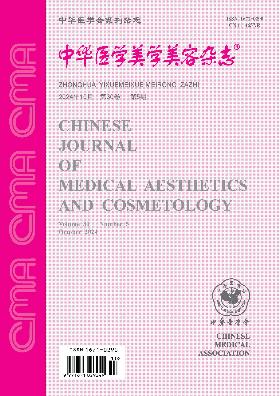鼻眉间皮瓣在鼻背侧和鼻尖重建中的临床应用
引用次数: 0
摘要
目的介绍一种修复鼻中、远端缺损的一期手术方法:鼻背侧眉间皮瓣。方法根据鼻缺损的大小、形状和位置,选择相应的鼻眉间背侧皮瓣修复鼻缺损17例。在17例病例中,有7名男性和10名女性,年龄在38至76岁之间。位置为鼻尖9例,鼻背8例,缺损面积为15mm×15mm至30mm×26mm,从松弛的眉间皮肤上取下组织,可能看起来过于激进,无法闭合鼻远端或中鼻缺损。然而,由于其设计主要是在眉间区域有背部切口的旋转皮瓣,因此它比原发性缺损更大,以最大限度地增加组织运动并降低皮瓣供区的伤口闭合张力。供区继发性缺损直接缝合。结果所有患者均成功修复鼻腔缺损,皮瓣全部成活。患者随访1~6个月,无肿瘤复发,修复后的组织在颜色、厚度和质地上与周围组织匹配良好,鼻腔轮廓良好,无继发畸形,美容效果满意。结论鼻眉间皮瓣为局部皮肤提供了与鼻腔皮肤完全匹配的颜色、厚度和质地,已成为治疗鼻腔覆盖缺损的首选皮瓣。它允许对多达30毫米的缺陷进行大型重建,留下最小的疤痕。它代表了重建鼻尖或鼻尖上缺损的一种有趣的替代方案。关键词:鼻子;皮肤;重建外科手术;外科皮瓣;鼻眉间皮瓣;缺陷本文章由计算机程序翻译,如有差异,请以英文原文为准。
Clinical effects of nasal glabellar flap on reconstruction of nasal dorsal and tip
Objective
To introduce an excellent one-stage procedure for repairing defects of the middle and distal part of the nose: nasal dorsal glabellar flap.
Methods
According to the size, shape and location of nasal defect, homologous nasal dorsal glabellar flap was selected to cover the nasal defect in 17 cases. Among 17 cases, there were 7 men and 10 women, with age of 38 to 76 years. The locations were nasal tip in 9 cases and dorsum of nose in 8 cases, The area of the defect ranged from 15 mm×15 mm to 30 mm×26 mm. The nasal dorsal glabellar flap, which received a versatile axial blood supply from branches of the facial artery and ophthalmic artery, took tissue from the lax glabellar skin and might appear to be too aggressive for closure of a distal nasal or mid-nasal defect. However, because its design was primarily that of a rotation flap with a back-cut in the glabella region, it was greater than the primary defect in order to maximize tissue movement and decreased wound closure tension at the flap donor site. The secondary defect of donor site was directly sutured.
Results
The nasal defect was successfully repaired in all patients, and the all flaps survived. The patients were available for follow-up of 1 to 6 months, no tumor recurrence occurred, and the repaired tissue were good match with surrounding tissue in color, thickness and texture, good nasal contour was obtained and no secondary deformity occurred, and therefore the cosmetic results were satisfactory.
Conclusions
The nasal glabellar flap has evolved into a choice flap for nasal defects of cover since it provides local skin with an exact color, thickness, and texture match for the nasal skin. It allows large reconstructions for up to 30 mm defects leaving minimal scars. It represents an interesting alternative for the reconstruction of defects of the nasal tip or supra tip of the nose.
Key words:
Nose; Skin; Reconstructive surgical procedures; Surgical flaps; Nasal glabellar flap; Defects
求助全文
通过发布文献求助,成功后即可免费获取论文全文。
去求助
来源期刊
自引率
0.00%
发文量
4641
期刊介绍:
"Chinese Journal of Medical Aesthetics and Cosmetology" is a high-end academic journal focusing on the basic theoretical research and clinical application of medical aesthetics and cosmetology. In March 2002, it was included in the statistical source journals of Chinese scientific and technological papers of the Ministry of Science and Technology, and has been included in the full-text retrieval system of "China Journal Network", "Chinese Academic Journals (CD-ROM Edition)" and "China Academic Journals Comprehensive Evaluation Database". Publishes research and applications in cosmetic surgery, cosmetic dermatology, cosmetic dentistry, cosmetic internal medicine, physical cosmetology, drug cosmetology, traditional Chinese medicine cosmetology and beauty care. Columns include: clinical treatises, experimental research, medical aesthetics, experience summaries, case reports, technological innovations, reviews, lectures, etc.

 求助内容:
求助内容: 应助结果提醒方式:
应助结果提醒方式:


